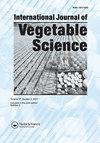编辑的字段-在…之间有一个空格。
IF 1.1
Q2 Agricultural and Biological Sciences
引用次数: 0
摘要
标题和目标,可以用几个段落分隔。然而,尽管它们被空间分隔开,但它们并没有被工作的意图或原因分隔开。摘要、引言、材料和方法都受做这项工作的原因的约束。摘要以一句话开头,说明为什么做这项工作很重要或有必要。这是对标题的具体回应。接下来是做了什么和下了决心。所有这些都将用一份关于为什么结果很重要的声明来总结。所有这些都是为了让读者明白为什么要做这项工作。通常在搜索过程中,读者唯一会遇到的就是摘要,这是完整手稿中提供的所有信息,减少到250字或更少。摘要是手稿的一个独立组成部分,旨在向读者提供相关信息。引言中的内容旨在告诉读者问题是什么,以及问题如何重要的充分相关背景。应提供支持正在做的事情或与正在进行的事情相反的重要信息。通常发生的情况是,引言的开头被大量的文字所消耗,这些文字详细说明了该作物在世界和/或开展工作的国家生产了多少,以及该作物的价值。这通常与标题中描述的内容无关。材料和方法吸收了进行工作的基本原理,并描述了工作是如何完成的。本节支持标题,但不改变其含义,或偏离标题和引言中所暗示的内容。它的设计是为了让读者能够重复或改变用于未来研究的方法。结果描述了材料和方法所解释的内容。最后是讨论。本节告诉读者为什么会出现结果,以及结果对知识体的重要性。本节采用了之前的所有内容,并将其与标题和目标联系起来,而不偏离手稿的整个内容和初衷的重要性。现在不是推测结果原因的时候,除非这种推测能得到数据或引文的支持。从头到尾,我们的目的是讲述一个连贯流畅的故事,从做这项工作的理由开始,到工作的重要性结束。国际蔬菜科学杂志2021,第27卷,第6期,513–514https://doi.org/10.1080/19315260.2021.1917115本文章由计算机程序翻译,如有差异,请以英文原文为准。
The editor’s field – There is a space between…
the title and the objectives which can be separated by several paragraphs. However, although separated by space they are not separated by intent or reason for doing the work. The abstract, introduction and materials and methods are bound by the reason for doing the work. The abstract is to be begun with a sentence that indicates why it was important, or necessary, to do the work. This is to be a specific response to the title. That is followed by what was done and what was determined. All of which is to be summarized with a statement of why the results are important. All of this is designed to aquatint the reader on why the work was done. Often during a search the only thing that a reader will encounter is the abstract, this is all the information provided in the full manuscript reduced to 250 words or less. The abstract is a stand alone component of the manuscript that is designed to provide the relevant information to the reader. What follows in the introduction is constructed to tell the reader what is the problem and sufficient relevant background on how the problem is important. The important information that supports what is being done, or which is contrary to what is being undertaken, is to be presented. What often occurs is that the beginning of the introduction is consumed by a volcanic flow of words that detail how much of whatever is the crop is produced in the world and/or the country in which the work was undertaken and how much the crop is worth. This often has no relevance to what is described in the title. The Materials and methods absorbs the rationale for doing the work and describes how the work was done. This section supports the title without changing its meaning, or deviating from what was implied in the title and introduction. It is designed to allow the reader to repeat, or change the methods used to undertake future research. The results describe what the Materials and methods explained. Finally comes the Discussion. This section tells the reader why the results occurred and how the results are important to the body of knowledge. This section takes all that has gone before and relates them to the title and objectives without deviating from the importance of the entire content and original intent of the manuscript. This is not the time to speculate on the reason for the results unless that speculation can be supported by data or citations. From beginning to end the aim is to tell a coherent and flowing story that began with a reason to do the work and ends with the importance of the work. INTERNATIONAL JOURNAL OF VEGETABLE SCIENCE 2021, VOL. 27, NO. 6, 513–514 https://doi.org/10.1080/19315260.2021.1917115
求助全文
通过发布文献求助,成功后即可免费获取论文全文。
去求助
来源期刊

International Journal of Vegetable Science
Agricultural and Biological Sciences-Plant Science
CiteScore
3.10
自引率
0.00%
发文量
30
期刊介绍:
The International Journal of Vegetable Science features innovative articles on all aspects of vegetable production, including growth regulation, pest management, sustainable production, harvesting, handling, storage, shipping, and final consumption. Researchers, practitioners, and academics present current findings on new crops and protected culture as well as traditional crops, examine marketing trends in the commercial vegetable industry, and address vital issues of concern to breeders, production managers, and processors working in all continents where vegetables are grown.
 求助内容:
求助内容: 应助结果提醒方式:
应助结果提醒方式:


